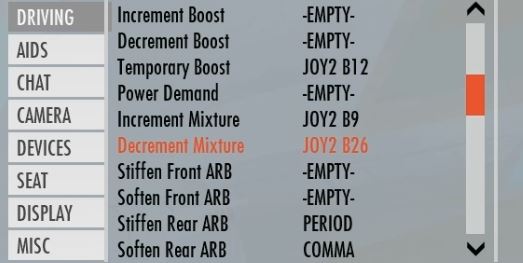Formula E Notes
Just starting out in Formula E – I have no idea how any of this works . . . lets dive in !
Torque Maps
eMotor Torque Map on the increment/decrement mixture buttons: This is basically your engine output. The higher the number setting, the more power you’ll output, the faster you’ll go. The trade off however (obviously), is that this comes at the expense of battery life. The higher the number, the faster you go, but the more battery you’ll use.
Regen Mode
Regen Mode on the engine brake map up/down buttons: This is the amount of power you put back into the battery off throttle. I downloaded a 3rd party plugin to see what effect this had on the rate recovered and from the numbers I saw, this energy seems to go back into the battery at the same rate when you are off the throttle or braking. Braking itself doesn’t seem to increase the rate recovered. (IE: when you are coasting with no brake, or on the brake hard, the rate that the energy is going back into the battery is the same. Hope this makes sense). The higher the setting, the more energy you’ll recover, however, this is at the expense of braking efficiency/effectiveness. The higher the number, the more energy you’ll recover off throttle, but the longer your braking distances will be. Lower the number, the better you’ll brake, but less energy will be put back into the battery.
HOW DO I DRIVE IT!
Formula E is different to most series you may have driven before, it’s about strategy and optimising your power and battery life.
Firstly you should set up a few more controls in the options menu.
- Increment mixture and decrement mixture – controls “eMotor Torque Map“

- Engine braking map up and down (New) – controls “Regen Mode“

Now what this does is affect the regen – so the power you get back from braking and also the engine power output which also affects the battery life.
For a Formula E race you usually have 1 stop, and Hong Kong is 45 laps for instance, so that means you need to go at least 23 laps on 1 stint (4.3%) per lap.
This means you need to lift and coast, for instance down the back straight you start coasting before the 200 metre board! If you saved more energy early due to a safety car or being very conservative, you can start lift and coasting later. Conversely, if you had to pit early due to damage or whatever reason, you may have to lift and coast even earlier.
After the lift and coast phase, you then brake late and if you have regen mode high, you will get more battery power back – there easy eh! Accelerating hard out of the corners will yield the main lap time benefits.
This car is all about how efficiently you can drive it. You have a set amount of energy to complete a race, and you have to find the most effective way to get to the end, that results in the shortest time possible.
Check the below video for an explanation.
TOP TIPS
- In qualifying you can run max power and high downforce, however in race use lower downforce to help eliminate drag
- Save as much power as possible to go for an attack at the end!
- Paint lines on street circuits are slippery, especially in the rain!
- 3rd party apps will give you a more precise reading on fuel, which will allow you to plan your race better
